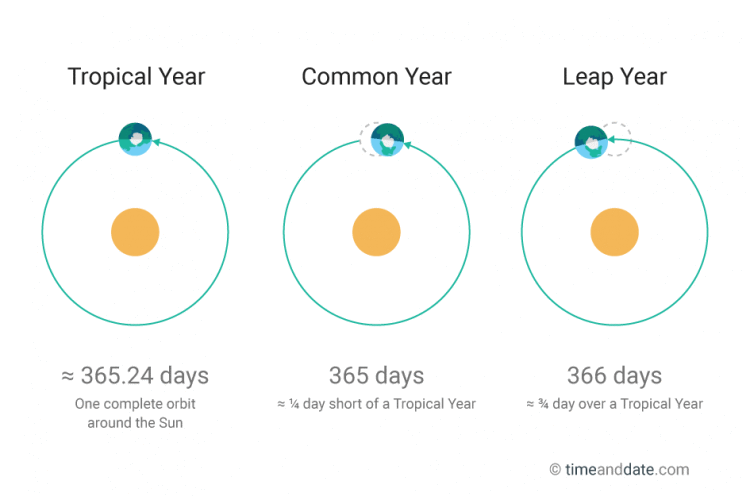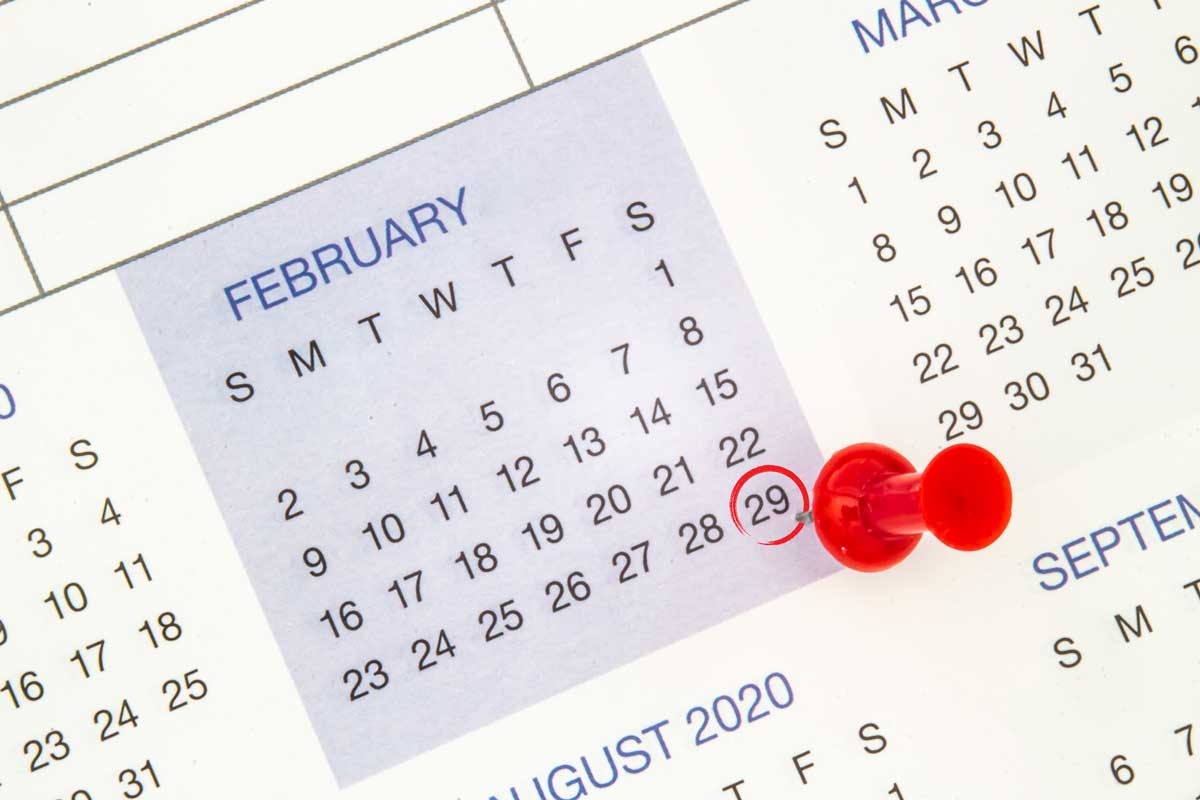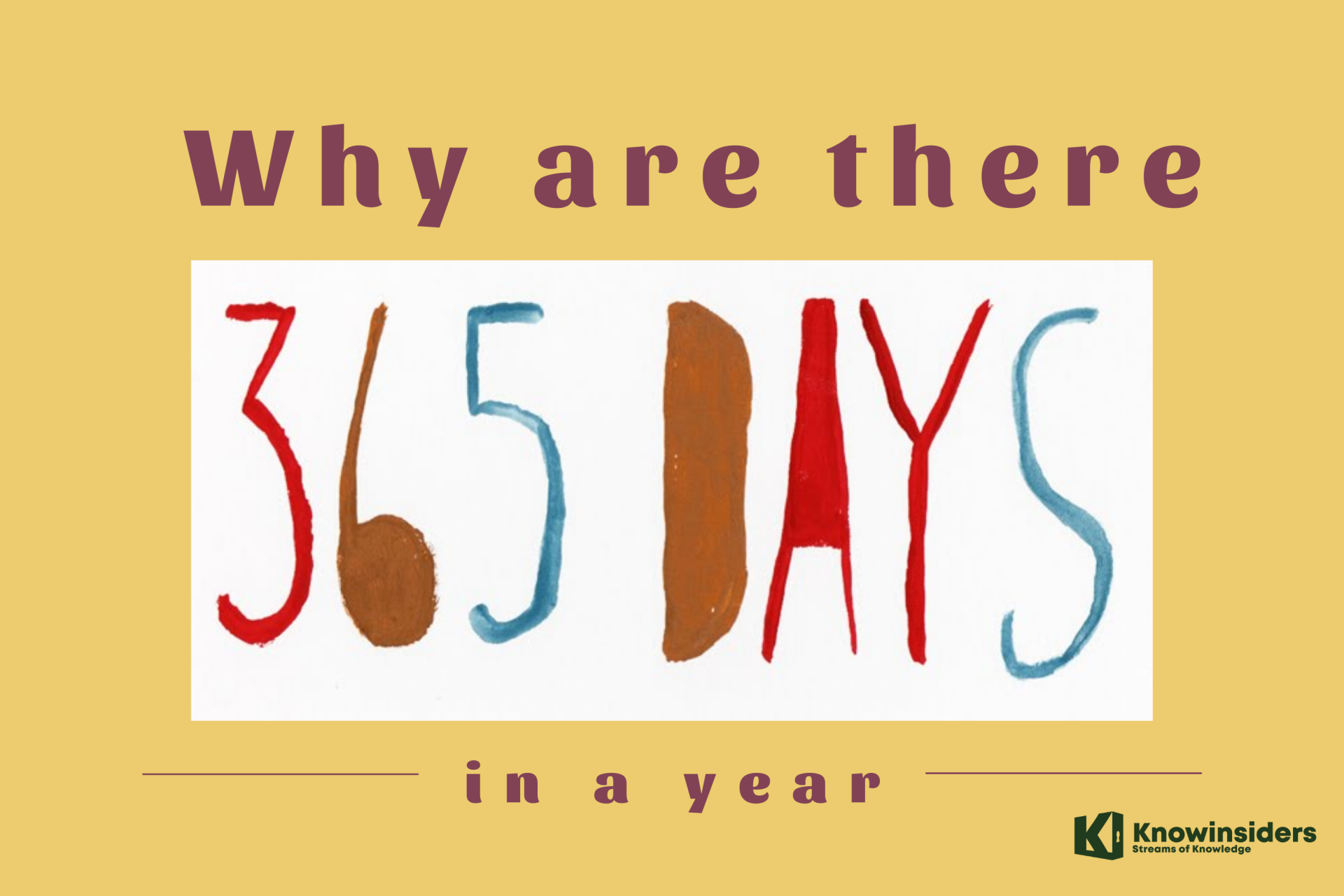Why Is There A Leap Year?
 |
| Why Is There A Leap Year? Photo KnowInsiders |
Leap years happen every four years, except if the year is a multiple of 100. But then years that are a multiple of 400 are also leap years. This complex arrangement has a 2000-year history.
What is Leap Year?
A leap year consists of 366 days as opposed to a ‘regular’ year that consists of 365 days. Every 4 years, a year comes along that has one more day to it, meaning 366 days in total. Those years with 366 days are leap years. More specifically, the year in which the month of February has 29 days (instead of the usual 28 days) is deemed a leap year. For example, the year 2016 was a leap year.
How often is Leap Year?
A leap year comes every 4 years. A normal year has 365 days, but every 4 years, a leap year comes which has 366 days, i.e. 1 day more than a normal year.
| Leap seconds A leap second was added on 31 December 2005, the first since 1998, to help keep clock-time aligned with time measured by the Sun. Another was added in 2008, 2012 and 30 June 2015. |
When did leap year originate?
 |
| Photo civilsdaily |
The Gregorian calendar is closely based on the Julian calendar, which was introduced byJulius Caesar in 45 BC to fix the Roman calendar (including adding a couple extra months). The Julian calendar featured a 12-month, 365-day year, with an intercalary day inserted every fourth year at the end of February to make an average year of 365.25 days. But because the length of the solar year is actually 365.242216 days, the Julian year was too long by .0078 days (11 minutes 14 seconds).
This may not seem like a lot, but over the course of centuries it added up. Until in the 16th century, the vernal equinox was falling around March 11 instead of March 21. In 1582,Pope Gregory XIIIadjusted the calendar by moving the date ahead by 11 days and by instituting the exception to the rule for leap years. This new rule, whereby a century year is a leap year only if divisible by 400, is the sole feature that distinguishes the Gregorian calendar from the Julian calendar.
Following the Gregorian reform, the number of days in the year was 365.2425 days, an even closer approximation to the solar year. At this rate, it will take more than 3,000 years for the Gregorian calendar to gain one extra day in error.
| Leap year rules For a year to be qualified as a leap year, it has to satisfy these two conditions: The year has to be perfectly divisible by 4. (e.g 2012, 2020 etc.) If the year is perfectly divisible by 100, then it’s not a leap year. However, if the same year is also perfectly divisible by 400, then it is a leap year (e.g. 1800 was not a leap year, since it was divisible by 100, but not by 400; but the years 1600, 2000 were). |
| List Of Leap Years Past And Present 1600 1604 1608 1612 1616 1620 1624 1628 1632 1636 1640 1644 1648 1652 1656 1660 1664 1668 1672 1676 1680 1684 1688 1692 1696 1704 1708 1712 1716 1720 1724 1728 1732 1736 1740 1744 1748 1752 1756 1760 1764 1768 1772 1776 1780 1784 1788 1792 1796 1804 1808 1812 1816 1820 1824 1828 1832 1836 1840 1844 1848 1852 1856 1860 1864 1868 1872 1876 1880 1884 1888 1892 1896 1904 1908 1912 1916 1920 1924 1928 1932 1936 1940 1944 1948 1952 1956 1960 1964 1968 1972 1976 1980 1984 1988 1992 1996 2000 2004 2008 2012 2016 2020 2024 2028 2032 2036 2040 2044 2048 2052 2056 2060 2064 2068 2072 2076 2080 2084 2088 2092 2096 2104 2108 2112 2116 2120 2124 2128 2132 2136 2140 2144 2148 2152 |
Why Does A Leap Year Have 366 Days?
 |
| Photo ucf |
There is a leap day every 4 years because Earth completes one revolution around the sun in around 365 days and 6 hours. Over a period of 4 years, the extra 6 hours from every year get added up to become an entire day (6*4=24 hours). Hence, we have a leap day/leap year every 4 years.
The month of February is a wee bit different from other months in the sense that every 4 years, out of nowhere, a 29th day is added to it, and the month of February becomes one day longer than usual!
| Leap Year doesn’t necessarily have to occur in February. Our collection of months is very peculiar. If we have a calendar that’s based on a 7-day week, there are 52 weeks plus one day in 365 days. Theoretically, you could have 13 months of 28 days and then have one loaner day — say New Year’s Day — that isn’t in a month. The particular mish-mash of 28-30-31 days that we have in our calendar is a question for an historian more than an astronomer. February gets it because it is shorter than the other months. But it really doesn’t matter. You could put it anywhere. |
Are leap years really that important?
Leap years are important so that our calendar year matches the solar year — the amount of time it takes for Earth to make a trip around the Sun. Subtracting 5 hours, 46 minutes and 48 seconds off of a year maybe doesn’t seem like a big deal. But, if you keep subtracting almost 6 hours every year for many years, things can really get messed up.
For example, say that July is a warm, summer month where you live. If we never had leap years, all those missing hours would add up into days, weeks and even months. Eventually, in a few hundred years, July would actually take place in the cold winter months!
READ MORE: Why are There 12 Months in a Year?
Do other planets have leap years?
Yes! Leap years happen because a planet’s orbit around the Sun (year) and rotation on its axis (day) are not perfectly in line. This is true of almost every other planet in our solar system, cited Space Place.
Mars, for example, has more leap years than regular years! A year on Mars is 668 sols, or Martian days. However, it takes 668.6 sols for Mars to go around the Sun. So, you would sometimes have to add a sol to help the calendar catch up. In a 10 year period, four of the years would have 668 sols and six of the years would be leap years with 669 sols.
What is Leap Day and When Is the Next Leap Day?
 |
| Photo history |
A Leap Day, February 29, is added to the calendar during leap years. This extra day, also called Leap Year Day, makes the year 366 days long – not 365 days
The next leap day is February 29, 2024.
2020 was also a leap year, so the last leap day was February 29, 2020.
WHEN IS THE NEXT LEAP YEAR?
| Leap Year | Leap Day |
|---|---|
| 2024 | Thursday, February 29 |
| 2028 | Tuesday, February 29 |
| 2032 | Sunday, February 29 |
| 2036 | Friday, February 29 |
What happens if you're born on leap day?
 |
| Photo kid101 |
You'll be called a leaper, leapling, or leap day baby. People with February 29th birthdays can choose to celebrate on February 28th or March 1st on non-leap years. According to History.com, about 5 million people around the world have February 29th birthdays, but the chances of having a leap birthday are only one in 1,461.
| People born on Leap Day are called 'Leaplings' There are only about 5 million people in the whole world who were born on February 29, with the odds of being born on Leap Day standing at about 1-in-1,461. Several famous people—including actress and singer Dinah Shore (born 1916), motivational speaker Tony Robbins (born 1960) and hip-hop artist Ja Rule (born 1976)—are leaplings. Leaplings technically only get to celebrate their birthdays once every four years, but they do get to be part of an elite group. |
Leap Day is often associated with marriage, proposals and flipping gender roles
Curiously, many Leap Day customs have revolved around romance and marriage. Tradition holds that in 5th-century Ireland, St. Bridget lamented to St. Patrick that women were not allowed to propose marriage to men. So legend has it that St. Patrick designated the only day that does not occur annually, February 29, as a day on which women would be allowed to propose to men. In some places, Leap Day thus became known as Bachelor's Day.
This tradition hopped the Irish Sea to Scotland and England, where the British added a twist—if a man rejected a woman's proposal, he owed her a debt of several pairs of fine gloves, perhaps to hide the fact that she did not have an engagement ring. In Greek tradition, however, it is considered bad luck to marry on Leap Day, and statistics suggest that Greek couples continue to take this superstition seriously.
Are Leap Years Bad Luck?
Many feel that to be born on Leap Day, thereby becoming a “leapling,” is a sign of good luck.
In some cultures, it is considered bad luck to get married during a leap year.
| We don’t know of any evidence supporting that marriage theory, but we do know that during leap years: Rome burned (64), and the Titanic sank (1912). By the same token, also in leap years: the Pilgrims landed at Plymouth, Massachusetts (1620), Benjamin Franklin proved that lightning is electricity (1752), and gold was discovered in California (1848). |
 Why are There 365 Days in a Year? Why are There 365 Days in a Year? Have you ever wondered why there are 365 days in a year instead of 364? Check out this article to find out the answer! |
 How Many Weeks Are There In a Year How Many Weeks Are There In a Year Any impatient soul counting down to their next birthday, annual holiday or festival is going to need 52 weeks' worth of patience, because that's the ... |
 How Many Days Are In A Year How Many Days Are In A Year Sometimes people can be confused trying to calculate how many days in a year, then this article will help you. Keep reading to know more ... |



























